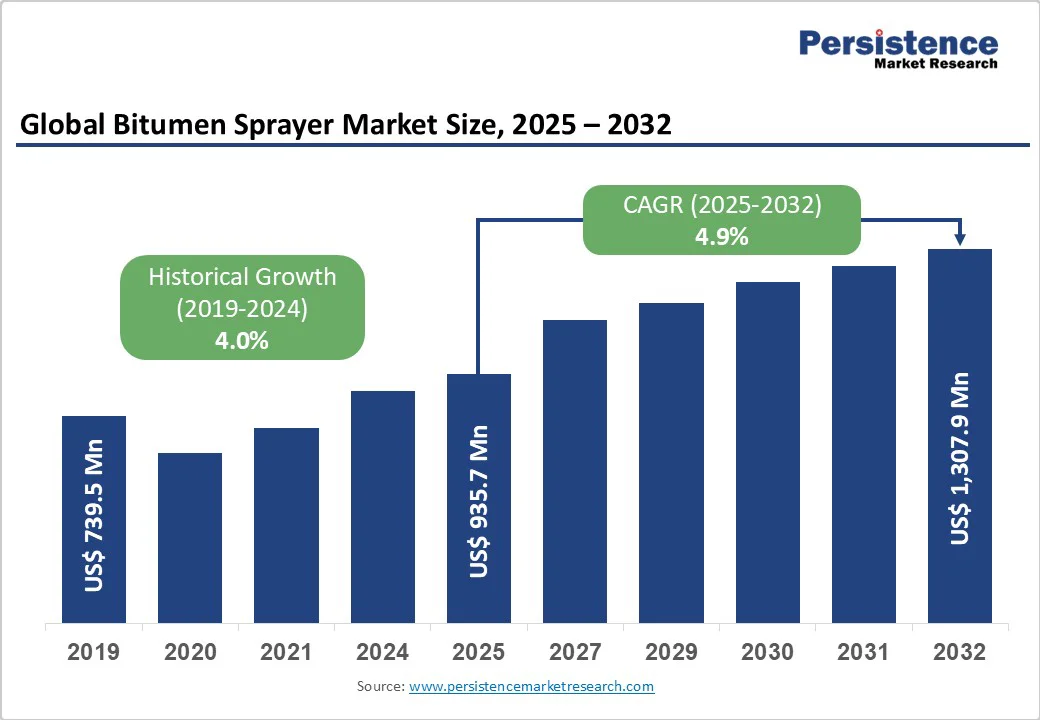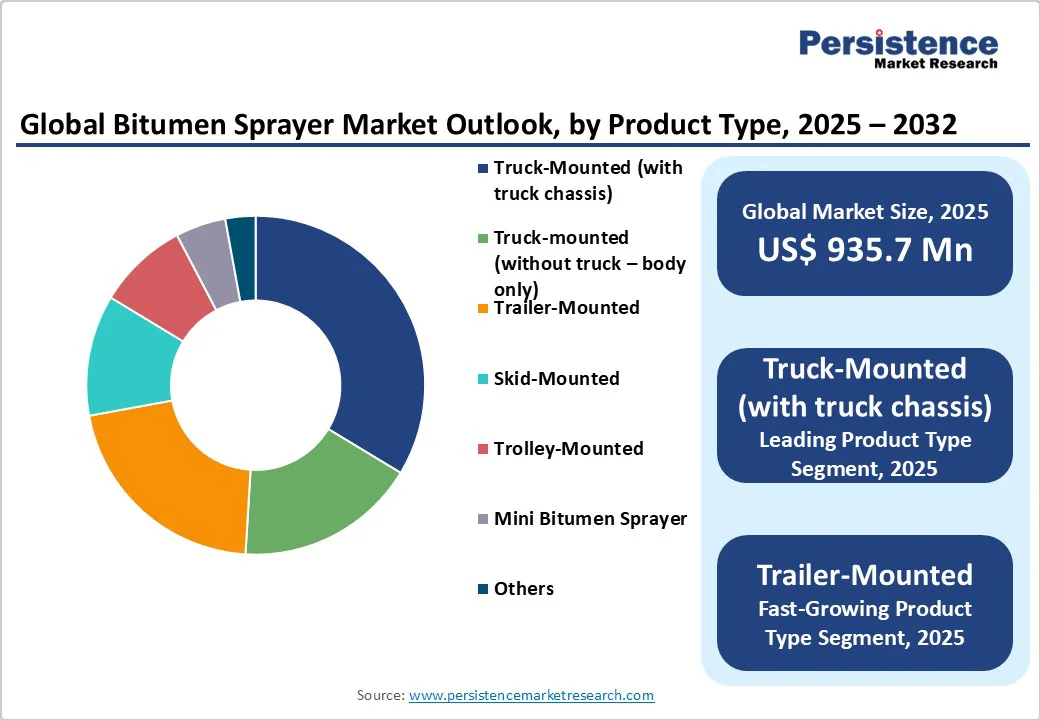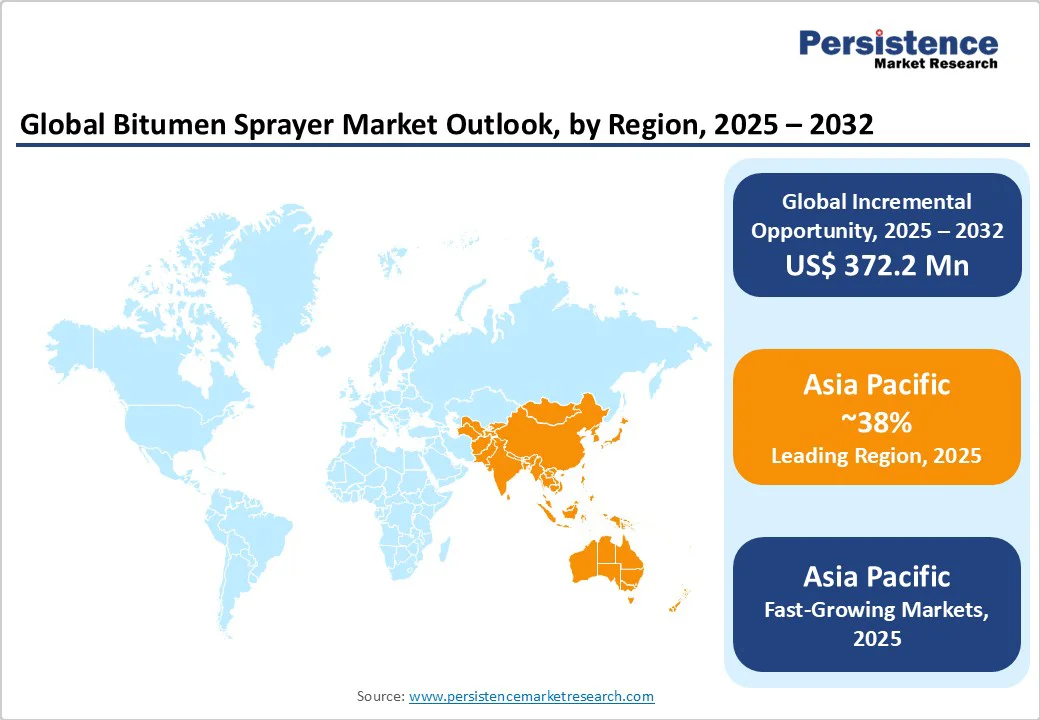ID: PMRREP35788| 199 Pages | 28 Oct 2025 | Format: PDF, Excel, PPT* | Industrial Automation

The global bitumen sprayer market size is likely to reach US$935.7 Million in 2025 and is expected to reach US$1,307.9 Million by 2032, growing at a CAGR of 4.9% during the forecast period from 2025 to 2032, driven by expanding road construction and maintenance activities across developing and developed economies.
Growth is driven by massive government road investments, with India allocating INR 3.9 lakh crore (US$47 billion) for highways in FY25, while urbanization and advanced bitumen sprayers boost construction efficiency and pavement quality.
| Key Insights | Details |
|---|---|
|
Bitumen Sprayer Market Size (2025E) |
US$935.7 Mn |
|
Market Value Forecast (2032F) |
US$1,307.9 Mn |
|
Projected Growth CAGR (2025-2032) |
4.9% |
|
Historical Market Growth (2019-2024) |
4.0% |

Rapid global infrastructure development is the main driver of the market. Large-scale government investments in highway expansion, rural connectivity, and urban road rehabilitation are driving steady demand for efficient spraying equipment. The World Bank projects that global infrastructure spending will exceed US$4 trillion annually by 2030, directly boosting the need for specialized construction machinery such as bitumen sprayers.
In the Asia Pacific, India’s road network expanded from 419,358 km in 2014-15 to 771,950 km in 2024-25, while China’s high-speed rail infrastructure grew by 12% in 2023. Similarly, the European Union earmarked US$8.13 billion in 2024 for road modernization, with Germany investing US$3.25 billion annually in motorway upgrades. These sustained investments underline a strong pipeline of construction activity, ensuring steady market growth.
Rapid technological innovation in bitumen sprayers is transforming operational performance and precision across road construction projects. Modern systems now feature GPS-guided tracking, IoT-enabled sensors, and AI-based predictive maintenance tools that monitor temperature, spray pressure, and flow rate in real time. These smart systems minimize material wastage by up to 20% and enhance coating uniformity across surfaces.
Automation-driven control panels and machine learning algorithms further optimize spray patterns by analyzing historical data, improving road surface quality while reducing operational costs. Advanced hydraulic controls and auto-calibration mechanisms support consistent bitumen distribution, even under challenging site conditions. Semi- and fully-automated sprayers also enhance worker safety and productivity, making them increasingly indispensable for large-scale and high-precision infrastructure projects worldwide.
The high initial investment required for advanced bitumen sprayer equipment remains a major constraint for market expansion. Modern sprayers equipped with GPS, automation, and precision control systems are priced between US$200,000 and US$1 million, depending on capacity and specifications. Such steep costs restrict adoption among small and medium-sized construction firms, especially in developing economies where budget constraints are prevalent.
Beyond acquisition costs, ongoing maintenance, operator training, and spare part expenses significantly increase the total cost of ownership. These financial barriers often limit access to advanced machinery, slowing modernization in the construction industry and curtailing broader market penetration in cost-sensitive regions.
Tightening global environmental regulations are increasingly restraining the market. Authorities in several regions have imposed strict limits on bitumen fume emissions, with some capping concentrations at 5 mg/m³. The European Union’s revised Industrial Emissions Directive has reduced polycyclic aromatic hydrocarbon (PAH) limits by 40% and expanded CO monitoring requirements.
Compliance with these regulations compels manufacturers to invest heavily up to US$2.32-5.80 Million per facility in advanced oxidation and filtration systems. This drives up production costs and challenges smaller manufacturers who are unable to meet stringent sustainability standards. As a result, the market faces higher equipment prices and slower adoption rates, despite the environmental benefits of cleaner technologies.
Rapid urbanization and infrastructure expansion in developing economies are opening significant growth avenues for the market. Nations across the Asia Pacific, Latin America, and Africa are investing heavily in road development to enhance connectivity and trade efficiency. Indonesia recorded a 25% increase in road construction projects in 2023, while India’s Infrastructure Australia initiative supported a 30% rise in urban road redevelopment during 2022–2023. Multilateral funding agencies such as the Asian Development Bank and the World Bank are further accelerating infrastructure spending across emerging markets, stimulating demand for reliable road construction machinery.
Aging infrastructure in developed regions such as North America and Europe is undergoing large-scale rehabilitation and maintenance. These initiatives focus on resurfacing and extending pavement life, driving continuous demand for advanced bitumen sprayers that enable efficient, cost-effective, and uniform bitumen application.
The global transition toward sustainable and intelligent construction practices is creating new opportunities for bitumen sprayer manufacturers. The growing adoption of low-emission engines, fuel-efficient designs, and environmentally compliant systems aligns with carbon-reduction goals and stricter emission norms. Manufacturers that prioritize green technologies are gaining traction among contractors and government agencies seeking eco-friendly infrastructure solutions.
The integration of IoT-enabled sensors, predictive maintenance, and automation in sprayers enhances performance monitoring, reduces downtime, and improves application accuracy. Rental-based business models are also gaining momentum, allowing smaller firms to access advanced equipment without heavy capital expenditure. Emerging technologies such as warm-mix asphalt (WMA) and polymer-modified bitumen formulations demand specialized spraying systems offering lucrative opportunities for manufacturers developing next-generation, sustainable bitumen application equipment.
Truck-mounted bitumen sprayers account for nearly 55–60% of the global market, making them the dominant product category due to their superior efficiency in large-scale infrastructure projects. These self-propelled systems feature integrated heating units, spray bars up to 4.5 meters, and capacities ranging from 6,000 to 10,000 liters, ensuring continuous operation over long stretches.
Their ability to cover extensive areas without the need for external towing vehicles reduces project costs and operational complexity. Advanced features such as GPS navigation, automated spray controls, and temperature regulation systems further enhance accuracy, consistency, and productivity, making them indispensable in highway and expressway construction.
The 4–8 ton capacity segment captures around 30–35% of the market, offering the ideal balance between efficiency, maneuverability, and project versatility. These models are well-suited for mid- to large-scale road projects and urban applications that require flexibility and extended operating times.
Particularly, 6–8 ton variants are gaining traction due to their optimized tank volume, built-in heating systems, and ability to maintain bitumen temperature for prolonged use. Equipped with automated flow control and adjustable spray widths, these sprayers ensure precise and uniform application, minimizing wastage and delivering cost-effective performance across varied road construction environments.
Road construction dominates the market with a 70–75% share, driven by massive global investments in highway, municipal, and rural road projects. Governments worldwide are prioritizing road expansion to support economic growth and improve connectivity, thereby reinforcing demand for efficient bitumen-spraying solutions.
Road maintenance and rehabilitation projects form a strong secondary segment as aging infrastructure requires regular upkeep. Specialized applications such as airport runways, bridge decks, and parking lots also rely on bitumen sprayers for consistent surface coating, durability, and load-bearing performance, ensuring continued demand across diverse construction sectors.

North America holds a significant 25% share of the market, primarily supported by extensive infrastructure modernization and rehabilitation programs. The U.S. remains the dominant contributor through the Infrastructure Investment and Jobs Act, which allocated over US$550 billion for transportation upgrades. This investment has stimulated large-scale procurement of advanced sprayers for highway reconstruction and maintenance. Canada’s focus on improving interprovincial connectivity and northern transport routes further strengthens regional demand for efficient road construction machinery.
Stringent environmental regulations across the U.S. and Canada encourage the use of low-emission and energy-efficient equipment. Manufacturers are responding with EPA-compliant sprayers incorporating automation, IoT-enabled monitoring, and predictive maintenance features. These innovations enhance operational precision, safety, and sustainability, aligning with North America’s commitment to technologically advanced and eco-conscious construction practices.
Europe accounts for approximately 22% of the market, led by Germany, France, the U.K., and Spain. The European Union’s Connecting Europe Facility allocated EUR 7 billion (US$8.12 billion) in 2024 for road modernization, while Germany continues to invest EUR 2.8 Billion (US$3.08 billion) annually in motorway upgrades. Regulatory harmonization across EU-27 nations promotes the adoption of bitumen sprayers that meet unified environmental and performance standards, driving consistency in product development and deployment.
Sustainability remains a central focus in Europe’s construction sector, supported by the EU’s Fit-for-55 decarbonization initiative. This has accelerated the adoption of warm-mix asphalt and polymer-modified bitumen, both of which require precision spraying systems. Central and Eastern European nations are experiencing infrastructure acceleration through EU structural funds and national programs to improve transport networks and cross-border connectivity, thereby ensuring sustained demand for modern spraying technologies.
Asia Pacific dominates the market with a 38% regional share, fueled by rapid urbanization and massive infrastructure investments. China leads through large-scale Belt and Road Initiative projects. At the same time, India continues to expand its road network growing from 419,358 km in 2014-15 to 771,950 km in 2024-25, supported by INR 3.9 lakh crore (US$46.99 Billion) allocated for FY25 road infrastructure. Japan and South Korea are advancing toward smart construction technologies, and ASEAN countries are prioritizing transport connectivity and urban development.
Manufacturing strength in China and India enables cost-effective production and export of bitumen sprayers, boosting regional competitiveness. The Asia Pacific construction equipment market is forecast to surpass US$100 billion by 2032, growing at a 10% CAGR, with road and concrete equipment leading the expansion. Government-backed infrastructure policies, smart city projects, and rural connectivity initiatives continue to sustain long-term market growth.

The global bitumen sprayer market features a moderately fragmented competitive structure, with a balanced presence of global and regional players offering diverse product portfolios. Competition is driven by continuous technological advancements, expanding production capacities, and growing emphasis on automation and operational efficiency. Manufacturers increasingly focus on integrating GPS-enabled tracking systems, precision flow controls, and emission-compliant engines to enhance performance and reduce environmental impact.
Industry participants are investing in digital transformation through IoT-based systems and predictive maintenance technologies that optimize fleet management and minimize downtime. The rise of rental and lease-based business models allows smaller contractors to access advanced spraying technologies, supporting wider equipment adoption across developing regions.
The bitumen sprayer market is projected to reach US$935.7 Million in 2025.
The primary demand drivers include a surge in global infrastructure development, government investments in road construction projects exceeding US$4 Trillion annually by 2030, and technological advancements in automation and IoT integration that enhance operational efficiency.
Truck-mounted bitumen sprayers lead the market with approximately 55-60% market share, driven by their superior mobility, high capacity, and integrated systems suitable for large-scale road construction projects.
Asia Pacific dominates the bitumen sprayer market with an estimated 38% regional share, led by China and India's massive infrastructure development programs and rapid urbanization trends.
Key opportunities include expansion in emerging markets with infrastructure modernization programs, a shift toward sustainable construction technologies, and the development of rental business models that expand market accessibility.
Key players in the bitumen sprayer market include Apollo Equipment, Kaushik Engineering Works, XCMG, Metong, Crafco Inc., Volvo, Caterpillar, and Fayat Group.
| Report Attribute | Details |
|---|---|
|
Historical Data/Actuals |
2019 - 2024 |
|
Forecast Period |
2025 - 2032 |
|
Market Analysis |
Value: US$ Mn |
|
Geographical Coverage |
|
|
Segmental Coverage |
|
|
Competitive Analysis |
|
|
Report Highlights |
|
By Product Type
By Capacity
By Application
By Region
Delivery Timelines
For more information on this report and its delivery timelines please get in touch with our sales team.
About Author